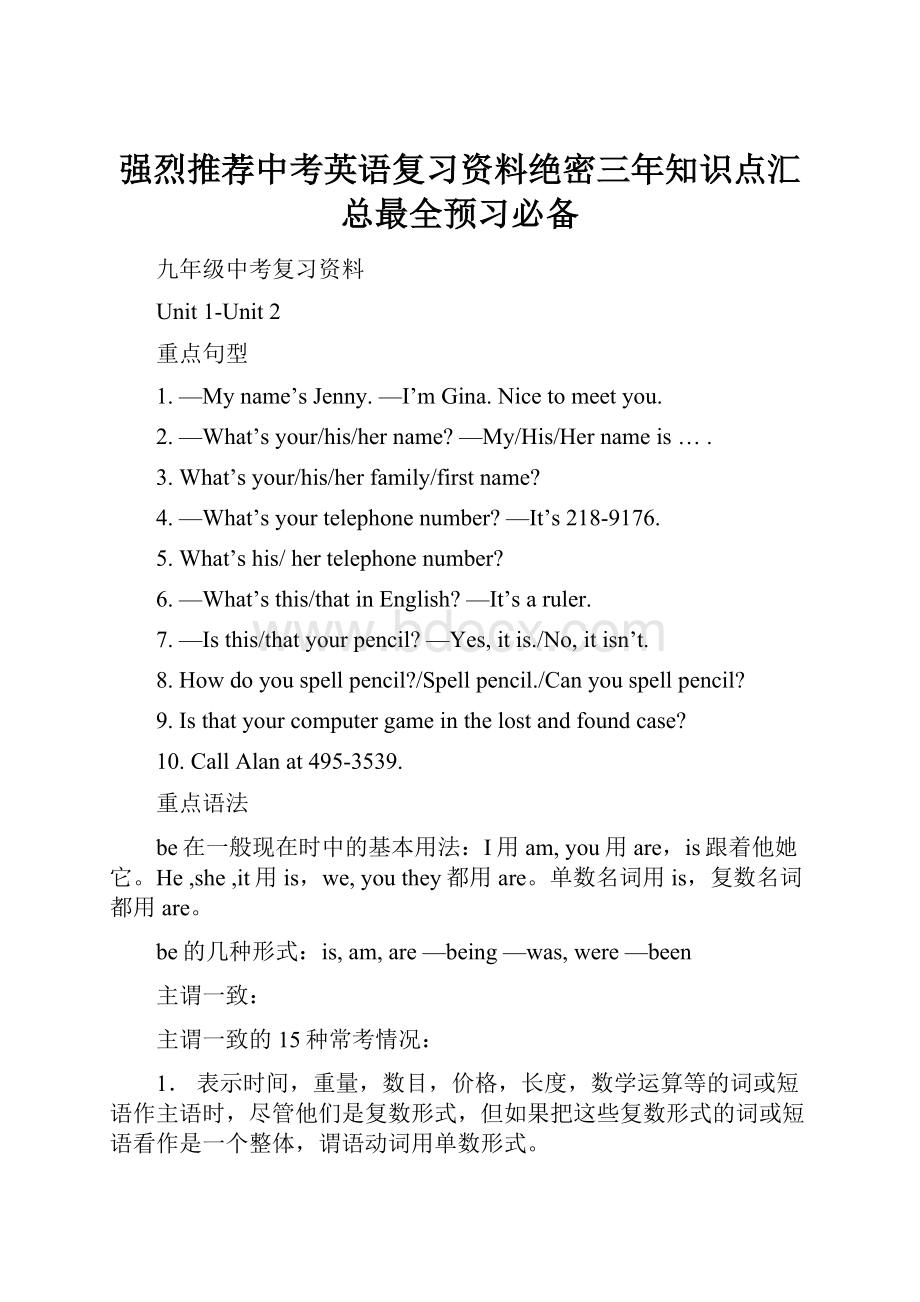 强烈推荐中考英语复习资料绝密三年知识点汇总最全预习必备.docx
强烈推荐中考英语复习资料绝密三年知识点汇总最全预习必备.docx
- 文档编号:11777763
- 上传时间:2023-04-01
- 格式:DOCX
- 页数:111
- 大小:137.68KB
强烈推荐中考英语复习资料绝密三年知识点汇总最全预习必备.docx
《强烈推荐中考英语复习资料绝密三年知识点汇总最全预习必备.docx》由会员分享,可在线阅读,更多相关《强烈推荐中考英语复习资料绝密三年知识点汇总最全预习必备.docx(111页珍藏版)》请在冰豆网上搜索。

强烈推荐中考英语复习资料绝密三年知识点汇总最全预习必备
九年级中考复习资料
Unit1-Unit2
重点句型
1.—Myname’sJenny.—I’mGina.Nicetomeetyou.
2.—What’syour/his/hername?
—My/His/Hernameis….
3.What’syour/his/herfamily/firstname?
4.—What’syourtelephonenumber?
—It’s218-9176.
5.What’shis/hertelephonenumber?
6.—What’sthis/thatinEnglish?
—It’saruler.
7.—Isthis/thatyourpencil?
—Yes,itis./No,itisn’t.
8.Howdoyouspellpencil?
/Spellpencil./Canyouspellpencil?
9.Isthatyourcomputergameinthelostandfoundcase?
10.CallAlanat495-3539.
重点语法
be在一般现在时中的基本用法:
I用am,you用are,is跟着他她它。
He,she,it用is,we,youthey都用are。
单数名词用is,复数名词都用are。
be的几种形式:
is,am,are—being—was,were—been
主谓一致:
主谓一致的15种常考情况:
1.表示时间,重量,数目,价格,长度,数学运算等的词或短语作主语时,尽管他们是复数形式,但如果把这些复数形式的词或短语看作是一个整体,谓语动词用单数形式。
Twomonthsisquitealongtime.Twentydollarsisenough.
2.动词不定式,动名词,从句或不可数名词作主语时,谓语动词用单数。
Toseeistobelieve.Itisnoteasytomasteraforeignlanguage.
3.由and连接两个成分作主语时,要根据其表示的意义来决定谓语动词的形式。
如果其表示的是一个整体的概念或指的是同一事物,谓语动词用单数,如果其表示的是两个不同的对象时,谓语动词用复数。
Thewriterandtheteacherarecoming.
Thepoetandteacherisoneofmyfriends.
4.集合名词people,police一般看作复数意义,其谓语动词用复数。
另外一些集合名词family,enemy,class,army等作主语时,谓语动词是用单数还是复数,要根据这些词在句中的实际含义而定。
当他们表示的是整体意义时,谓语用单数;当他们强调个体成员时,谓语动词用复数形式。
InEngland,peopleeatfishandchips.
TheChinesepeople(民族)isagreatpeople.
5.名词性物主代词mine,yours,his,hers,its,ours,theirs等作主语时,谓语动词的数取决于该代词所表示的意义是单数还是复数。
Hisparentsareyoung,butmineareold.
6.以s结尾的名词本身不表示复数意义时,谓语动词通常用单数形式,如news,physics,politics,maths等。
Nonewsisgoodnews.Physicsisthemostdifficultsubjectforhim.
7.由or,either…or…,neither…nor…,notonly…butalso…等词连接名词或代词作主语时,谓语动词的数和最接近的主语一致。
NeitheryounorLiHuahasbeentoShanghaibefore.
8.以there,here开头的句子,若主语不止一个,其谓语动词的形式和邻近的那个主语一致。
Thereisatableandfourchairsintheroom.
Herearesomebooksandpaperforyou.
9.trousers,clothes,glasses,compasses,chopsticks等作主语时,谓语动词用复数。
但如果前面有apairof短语时,谓语动词用单数。
Jim’strousersarebrown.ThepairofglassesisMr.Green’s.
10.由“alotof/lotsof/plentyof+名词”或“分数+名词”作主语时,谓语动词的单复数根据名词的单复数而定。
AlotofpeoplehavebeentoLondon.
Three-fifthsofthewaterisdirty.
11.“anumberof+复数名词”作主语时,谓语动词用复数;“thenumberof+复数名词”作主语时,谓语动词用单数。
Agreatnumberofbirdsflytothesouthinwinter.
Thenumberoflionsdoesnotchangemuchifpeopleleavethingsastheyare.
12.代词something,anything,nothing,everyone,anybody,nobody,each,neither,either,little,much,one等作主语时,谓语动词用单数形式。
Neitherofusisaboy。
EachofthemhasanEnglishdictionary。
Oneofthestudentswaslateforschool。
13.All,somenone,most,any等代词作主语时,若其指复数概念,谓语动词用复数形式;若其指单数形式,则谓语动词用单数形式。
Notallworkisdifficult。
Notallthestudentsarehere。
14.有些形容词前面加上定冠词the,如thepoor,theold,theyong,therich,thedying等用来表示一类人时,主语为复数意义,谓语动词用复数。
Theoldaregoodtakencareof。
15.Manya意为“许多”,但因后面跟的是单数名词,谓语动词应用单数形式。
Manyastudenthaspassedtheexam。
Units3-4复习要点
1、介绍家庭成员This/Thatismysister/brother/mother…
These/Thosearemyparents/grandparents…
Isthis/thatyoursister/brother…?
Yes,itis./No,itisn’t.
Arethese/thoseyourparents/grandparents…?
Yes,theyare./No,theyaren’t.
Thereare3/4/5…peopleinmyfamily.Theyaremyfather,mymother,…andI.
2、关于方位介词或短语
表方位的介词或短语有:
in,on,under,behind,near,nextto,infrontof,acrossfrom,…
Mybookisonmydesk,mypenisinmybook…
Whereisthebackpack/pencil…?
It’sin/on/under….
Wherearethebooks/pens/balls…?
Theyarein/on/under….
3、把…带去给某人take…toe.g:
Pleasetakethesethingstoyoursister.
把…带来给某人bring…toe.g:
Canyoubringmyhomeworktoschool?
二、代词(有两种:
人称代词和物主代词。
)
1、人称代词分为:
第一、第二、第三人称,且有单复数之分。
2、人称代词的主格在句中做主语,一般用在动词前(疑问句除外);宾格在句中做宾语,多用于动词、介词后。
3、形容词性物主代词起形容词的作用,后面一定要跟名词,表示该名词是属于谁的。
4、名词性物主代词=形容词性物主代词+名词。
如:
Thisismybag.=Thisismine. Thatisherruler.=Thatishers.
一般看后面有没有名词,如有,就用形容词性物主代词;如无,就用名词性物主代词。
请牢记下表:
其他代词(有反身代词,指示代词,不定代词,疑问代词,相互代词和关系代词)
1、反身代词:
表示某人自己的代词
人称数
单数
复数
第一人称
myself
ourselves
第二人称
yourself
yourselves
第三人称
himself
herself
itself
themselves
反身代词在句中可作宾语、同位语、表语等,在使用时应注意它和它所指代的名词和代词在人称、性、数上的一致性。
LittleJimmycandresshimselfnow。
小吉米现在能自己穿衣服了。
(作宾语)
Theboyinthepictureismyself,notanyoneelse。
照片上的男孩不是别人,正是我自己。
(作表语)
Imyselfmadethemistakeaboutyouraddress。
我自己把你的地址搞错了。
(作同位语)
指示代词
指示代词是用来指示或标示人或事物的代词,表示“这个(些)”“那个(些)”,他们主要有:
单数
复数
近指
this这个
these这些
远指
that那个
those那些
1.this,these往往指时间或空间较近的人或物;that,those可指时间或空间较远的人和物。
Thisgiftisforyouandthatoneisforyourbrother.
这件礼物是你的,那件是你弟弟的.(this近指,that远指)
IlikethesegamesbutIdon’tlikethose.
我喜欢这些游戏,但不喜欢那些.(these近指,those远指)
2.that,those常常用来代替前面已提到过的名词,以避免重复。
those代指复数形式,that代指单数形式。
Thecomputerworksfasterthanthoseweboughtlastyear。
这些计算机比我们去年买的工作速度快。
Thelifeinthecountryismorepeacefulthanthatinthecity。
乡村生活比城市的生活要安静。
对于上文中所提到的事物,英语中常用that或those表示,而汉语却常用“这”表示。
如:
Ihadabadcold。
That’swhyIdidn’tattendthelecture。
我感冒了,这就是我为什么没去听讲座的原因。
ThosearetheDVDsyouwant。
这就是你要的DVD碟片。
Units5-6
重点句型:
Doyouhaveabasketball?
Yes,Ido./No,Idon’t.
Let’swatchTV.No,thatsoundsboring.
Thatsoundsgreat.
Doyoulikehamburgers?
Yes,Ido./No,Idon’t.
IlikeFrenchfries.Idon’tliketomatoes.
重点语法:
名词
一.名词的分类:
名词分为专有名词和普通名词。
专有名词指个人,地方,机构等专有名称.如:
China,Shanghai,Lilei。
普通名词又分为个体名词:
某类人或东西中的个体.如fighter,gun,country,集体名词:
若干个体组成的集合体.如family,team,police,class
物质名词:
无法分为个体的实物。
如cotton,tea,air,
抽象名词:
动作,状态,品质,感情等抽象概念.如:
health,happiness.
个体名词和集体名词又叫做可数名词.
物质名词和抽象名词又叫做不可数名词.
二.名词的数。
可数名词都有单数和复数之分。
Ⅰ:
规则的可数名词变复数的规则如下:
1.一般情况加s:
books,mouths,houses,girls
2.以s,sh,ch,x结尾的es:
classes,boxes,matches
3.辅音字母+y结尾的变y为i,再加es:
cities,countries,parties,factories
4.以o结尾的词多数+esheroesNegroespotatoestomatoes
zeroes/zeros
以o结尾并且词尾有两个元音字母+sradios,zoos,bamboos,(pianos,kilosphotos是特殊)
5.以f,fe结尾的改f,或fe为v,再+es,例如:
leaves,lives,wivesknives,halves,wolves
Thethief’swifekilledthreewolveswithsomeleavesandknivesinhalfofherlife.
但是,也有一些+s,如roofs,proofs,gulfs,beliefs,
handkerchiefs/handkerchieves
Ⅱ:
不规则的可数名词变复数的规则:
1.man—men,woman—women,tooth—teeth,foot—feet,
child—children,mouse—mice,
2.单复数相同:
sheep,fish,deer,means,Chinese,Japanese,
fish如表示不同种类的鱼时复数是fishes;
Therearemanykindsoffishesinthatlake.
3.以man,woman修饰名词构成合成词时,两个词都变化.
manservant—menservants(男仆).(boy/girlstudents)
womandoctor—womendoctors.
4.复合名词的复数形式:
son-in-law----sons-in-law(主体名词变化)
film-goer----film-goers,grown-up----grown-ups
(如果没有主体名词,在词尾加复数)
5.字母,阿拉伯数字的复数形式一般加“’s”或“s”.
Therearetwol’sintheword“all”.
Ithappenedinthe1960’s/1960s.
Iwillnotacceptyourif’sandbut’s.
6.物质名词一般没有复数,有时用复数形式表示不同种类,
wheats,fruits,vegetables,有时表示更广的词义,
wood—woods,water—waters,sand—sands
7.定冠词加姓氏的复数表示一家人。
theTurners,
theSmiths,theWangs.
8.集体名词people,police,cattle总是作复数,
(people作民族,种族时有单复数两种形式)
Manycattlearekept.
Severalpolicewereonduty.
TheChineseareabraveandhard-workingpeople.
TheEnglishareafunnypeople.
9.集体名词class,public,family,population,team,crew,committee等单复数都有,但意义不同。
Theclassisbig.----TheclassaretakingnotesinEnglish.
ThepopulationinChinaislarger.----80%ofthepopulation
inChinaarepeasants.
10.hair,fruit通常作单数,表示总体。
Hishairisgrey.arichharvestoffruit
如果表示若干根头发,表示种类的水果时,可以加复数词尾。
Hehadafewwhitehairs.
Whatfruitsareonsaleinthisseason?
11.以s结尾的学科名词只作单数。
mathematics,physics,politics,等。
(news)
12.glasses,trousers,scissors,shoes,spectacles,等常用复数;但如果这些词前用apairof…//thispairof…//thatpairof…等修饰时谓语动词有pair来决定。
Wherearemyglasses?
Mynewpairoftrousersistoolong.
Herearesomenewpairsofshoes.
13.不可数名词没有复数形式,如果表示“一个”的概念,可用单位词。
apieceofnews/information/advice/bread/cake/paper/meat/coal…
abottleofink,agrainofrice,acakeofsoap…
说明:
可数名词和不可数名词之间并没有截然的界限;可数名词可以转变为不可数名词,同样不可数名词也可以转变为可数名词,要看清整个上下文的具体内容。
三.名词的所有格。
Ⅰ.有生命的名词所有格的构成:
A.一般在词尾’s.theteacher’soffice,XiaoLi’ssister’shusband’smother.
B.以s结尾的复数名词只加’workers’resthomes.themasses’request
C.不以s结尾的复数名词加’s.
children’stoysWomen’sDay
D:
复合名词只在最后一个词的后面加’s.mysister-in-law’sbrother.
E:
表示共同所有的几个名词,只在最后一个词的后面加’s.
ThisisTom,JamesandDick’sroom.
F:
表示各个所有关系的几个名词,在每个名词后分别加’s.
Jenny’s,Jean’sandMary’sroomsfacetothesouth.
G:
名词短语只在最后一个词后加’s.
aquarterofanhour’stalk.
Ⅱ.名词所有格的用法:
1.名词所有格主要用于表示有生命的名词,表示所属关系。
LeiFeng’sdairy.theWorkingPeople’sPalaceofCulture.
2.也可用于表示时间的名词。
today’spaper.anhour’sdrive.Friday’swork.
3.也可用于表示地理、国家、城市等名词。
thecountry’splan.thefarm’sfruit.China’spopulation.
4.也可用于表示由人组成的集体名词。
ourParty’sstand(党的立场)
5.也可用于表示度量、价值的名词。
twodollars’worthofbooks.apound’sweight.
(现代英语中,这种用法越来越多。
)
Ⅲ.凡不能用’s属格的情况可用of属格表示所属关系。
theCityofNewYork.amapofChina.
特别是下列情况要用of属格:
⑴当名词有较长的定语时,
thenameofthegirlstandingatthegate.
Haveyoureadthearticlesofthestudentswhowerewithusyesterday.
⑵所修饰的名词前有数量词时,
aplayofComradeLi’s.somefriendsofmybrother’s.
⑶所修饰的名词前有一个指示代词时,
thatperformanceoftheteachers’.
Ⅳ.双重所有格:
当of前面的名词有不定冠词、指示代词、疑问代词、不定代词或数词如a,an,this,that,these,those,two,three,four,any,some,several,no,few,another等修饰时,用双重所有格,双重所有格只用于表示人的名词并且都是特指的。
apoemofLuXun’s.afriendofhis/hers.
WhichnovelofDicken’sareyoureading?
somefriendsofmybrothers’.
5.几种特殊情况:
thekeytothedoor.keystotheexercises.
notestothetextanswerstothequestion
ticketsforthefilm//movie
acheckfor$1500.anyoneelse’sbook.
themonumenttothepeople’sheroes.
theentrancetothestation//cinema
在现代英语中of属格大都可用’s所有格代替。
Units7—8
重点句型
1Howmuch
- 配套讲稿:
如PPT文件的首页显示word图标,表示该PPT已包含配套word讲稿。双击word图标可打开word文档。
- 特殊限制:
部分文档作品中含有的国旗、国徽等图片,仅作为作品整体效果示例展示,禁止商用。设计者仅对作品中独创性部分享有著作权。
- 关 键 词:
- 强烈推荐 中考 英语 复习资料 绝密 三年 知识点 汇总 预习 必备
 冰豆网所有资源均是用户自行上传分享,仅供网友学习交流,未经上传用户书面授权,请勿作他用。
冰豆网所有资源均是用户自行上传分享,仅供网友学习交流,未经上传用户书面授权,请勿作他用。


 铝散热器项目年度预算报告.docx
铝散热器项目年度预算报告.docx
